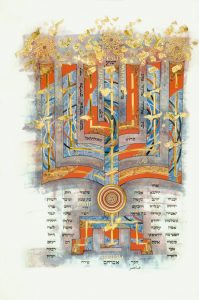
In the beginning of Mathew’s Gospel, the reader is introduced to the genealogy of Christ. One can assume that the author of the Gospel began in this manner to portray the humanity of Jesus while at the same time showing his divinity. The image that appears is a beautiful image of a menorah. Matthew in his time was primarily writing to a Jewish audience, so the image is quite appropriate, not just because of the audience he was addressing his gospel to, but also because Jesus himself was a Jew.
Menorahs are familiar objects to Jews, but this menorah depicts more than the usual object. In fact, Susan Sink writes in The Art of the Saint John’s Bible:
The menorah from Jewish tradition becomes a family tree, from which the names of the genealogy branch out. Matthew wrote for a Jewish audience and set Jesus’ birth within a Jewish context. The line of Jesus through David was important for establishing his divinity. Abraham and Sarah are at the root of this tree, and Hagar is there too, with her name in Arabic as well as Hebrew and English, the branch that leads through Ishmael to Islam. (Vol. 2. pp. 51)
She guides the reader further to notice:
The gilded stamps used in the center of the illustration come from illuminations of the Koran. A mandala is incorporated into the base of the menorah, again a sign of cosmic unity and wholeness found in many religious traditions.
This detail is important to this image because it seeks to show the interconnectedness of not only religions but also creation. Sink invites us to contemplate on “life, on creation, on history and redemption, on identity.” (Ibid.) What a great way to begin the Gospel!
This commentary was contributed by James Gumataotao, a senior Theology major and a member of the Library’s Research Desk team.